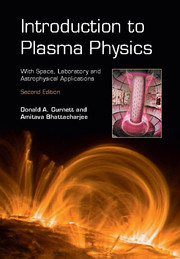Book contents
- Frontmatter
- Dedication
- Contents
- Preface
- 1 Introduction
- 2 Characteristic Parameters of a Plasma
- 3 Single-Particle Motions
- 4 Waves in a Cold Plasma
- 5 Kinetic Theory and the Moment Equations
- 6 Magnetohydrodynamics
- 7 MHD Equilibria and Stability
- 8 Discontinuities and Shock Waves
- 9 Electrostatic Waves in a Hot Unmagnetized Plasma
- 10 Waves in a Hot Magnetized Plasma
- 11 Nonlinear Effects
- 12 Collisional Processes
- Appendix A Symbols
- Appendix B Useful Trigonometric Identities
- Appendix C Vector Differential Operators
- Appendix D Vector Calculus Identities
- Index
1 - Introduction
Published online by Cambridge University Press: 16 March 2017
- Frontmatter
- Dedication
- Contents
- Preface
- 1 Introduction
- 2 Characteristic Parameters of a Plasma
- 3 Single-Particle Motions
- 4 Waves in a Cold Plasma
- 5 Kinetic Theory and the Moment Equations
- 6 Magnetohydrodynamics
- 7 MHD Equilibria and Stability
- 8 Discontinuities and Shock Waves
- 9 Electrostatic Waves in a Hot Unmagnetized Plasma
- 10 Waves in a Hot Magnetized Plasma
- 11 Nonlinear Effects
- 12 Collisional Processes
- Appendix A Symbols
- Appendix B Useful Trigonometric Identities
- Appendix C Vector Differential Operators
- Appendix D Vector Calculus Identities
- Index
Summary
A plasma is an ionized gas consisting of positively and negatively charged particles with approximately equal charge densities. Plasmas can be produced by heating an ordinary gas to such a high temperature that the random kinetic energy of the molecules exceeds the ionization energy. Collisions then strip some of the electrons from the atoms, forming a mixture of electrons and ions. Because the ionization process starts at a fairly well-defined temperature, usually a few thousand K, a plasma is often referred to as the “fourth” state of matter. Plasmas can also be produced by exposing an ordinary gas to energetic photons, such as ultraviolet light or X-rays. The steady-state ionization density depends on a balance between ionization and recombination. In order to maintain a high degree of ionization, either the ionization source must be very strong, or the plasma must be very tenuous so that the recombination rate is low.
The definition of a plasma requires that any deviation from charge neutrality must be very small. For simplicity, unless stated otherwise, we will assume that the ions are singly charged. The charge neutrality condition is then equivalent to requiring that the electron and ion number densities be approximately the same. In the absence of a loss mechanism, the overall charge neutrality assumption is usually satisfied because all ionization processes produce equal amounts of positive and negative charge. However, deviations from local charge neutrality can occur. Usually these deviations are small, since as soon as a charge imbalance develops, large electric fields are produced that act to restore charge neutrality. Systems that display large deviations from charge neutrality, such as vacuum tubes and various electronic devices, are not plasmas, even though some aspects of their physics are similar.
In the most common type of plasma, the charged particles are in an unbound gaseous state. This requirement can be made more specific by requiring that the random kinetic energy be much greater than the average electrostatic energy, and is imposed to provide a distinction between a plasma, in which the particles move relatively freely, and condensed matter, such as metals, where electrostatic forces play a dominant role.
Information
- Type
- Chapter
- Information
- Introduction to Plasma PhysicsWith Space, Laboratory and Astrophysical Applications, pp. 1 - 3Publisher: Cambridge University PressPrint publication year: 2017
